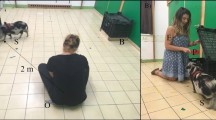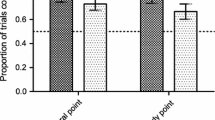Abstract
One advantage of living in a social group is the opportunity to use information provided by other individuals. Social information can be based on cues provided by a conspecific or even by a heterospecific individual (e.g., gaze direction, vocalizations, pointing gestures). Although the use of human gaze and gestures has been extensively studied in primates, and is increasingly studied in other mammals, there is no documentation of birds using these cues in a cooperative context. In this study, we tested the ability of three African gray parrots to use different human cues (pointing and/or gazing) in an object-choice task. We found that one subject spontaneously used the most salient pointing gesture (looking and steady pointing with hand at about 20 cm from the baited box). The two others were also able to use this cue after 15 trials. None of the parrots spontaneously used the steady gaze cues (combined head and eye orientation), but one learned to do so effectively after only 15 trials when the distance between the head and the baited box was about 1 m. However, none of the parrots were able to use the momentary pointing nor the distal pointing and gazing cues. These results are discussed in terms of sensitivity to joint attention as a prerequisite to understand pointing gestures as it is to the referential use of labels.


Similar content being viewed by others
References
Anderson JR (1998) Social stimuli and social rewards in primate learning and cognition. Behav Processes 42:159–175
Anderson JR, Montant M, Schmitt D (1996) Rhesus monkeys fail to use gaze direction as an experimenter-given cue in an object-choice task. Behav Processes 37:47–55
Anderson JR, Sallaberry P, Barbier H (1995) Use of experimenter-given cues during object-choice tasks by capuchin monkeys. Anim Behav 49:201–208
Baldwin DA (1991) Infants’ contribution to the achievement of joint reference. Child Dev 62:875–890
Barth J, Reaux JE, Povinelli DJ (2005) Chimpanzees’ (Pan troglodytes) use of gaze cues in object-choice tasks: different methods yield different results. Anim Cogn 8:84–92
Behne T, Carpenter M, Tomasello M (2005) One-year-olds comprehend the communicative intentions behind gestures in a hiding game. Dev Sci 8:492–499
Bradbury JW (2003) Vocal communication in wild parrots. In: de Waal FBM, Tyack PL (eds) Animal social complexity: intelligence culture and individualized societies. Harvard Press, Cambridge, pp 293–316
Bugnyar T, Stöwe M, Bernd H (2004) Ravens, Corvus corax, follow gaze direction of humans around obstacles. Proc Biol Sci 271:1331–1336
Call J, Hare BA, Tomasello M (1998) Chimpanzee gaze following in an object-choice task. Anim Cogn 1:89–99
Call J, Tomasello M (1994) Production and comprehension of referential pointing by Orangutans (Pongo pygmaeus). J Comp Psychol 108:307–317
Danchin E, Giraldeau L-A, Valone TJ, Wagner RH (2004) Public information: from nosy neighbors to cultural evolution. Science 305:487–491
Dominey PF, Dodane C (2004) Indeterminacy in language acquisition: the role of child directed speech and joint attention. J Neurolinguistics 17:121–145
Emery NJ, Clayton DH (2001) Effects of experience and social context on prospective caching strategies by scrub jays. Nature 416:443–446
Emery NJ, Dally JM, Clayton NS (2004) Western scrub-jays (Aphelocoma californica) use cognitive strategies to protect their caches from thieving conspecifics. Anim Cogn 7:37–43
Evans CS (1997) Referential signals. Perspect Ethol 12:99–143
Farroni T, Mansfield EM, Lai C, Johnson MH (2003) Infants perceiving and acting on the eyes: tests of an evolutionary hypothesis. J Exp Child Psychol 85:199–212
Gómez J-C (2005) Species comparative studies and cognitive development. Trends Cogn Sci (Regul Ed) 9:118–125
Hare B, Brown M, Williamson C, Tomasello M (2002) The domestication of social cognition in dogs. Science 298:1634–1636
Hare B, Plyusnina I, Ignacio N, Schepina O, Stepika A, Wrangham R, Trut L (2005) Social cognitive evolution in captive foxes is a correlated by-product of experimental domestication. Curr Biol 15:226–230
Hare B, Tomasello M (1999) Domestic dogs (Canis familiaris) use human and conspecific social cues to locate hidden food. J Comp Psychol 113:173–177
Itakura S, Agnetta B, Hare B, Tomasello M (1999) Chimpanzee use of human and conspecific social cues to locate hidden food. Dev Sci 2:448–456
Itakura S, Tanaka M (1998) Use of experimenter-given cues during object-choice tasks by chimpanzees (Pan troglodytes), an orangutan (Pongo pygmaeus), and human infants (Homo sapiens). J Comp Psychol 112:119–126
Kaminski J, Riedel J, Call J, Tomasello M (2005) Domestic goats, Capra hircus, follow gaze direction and use social cues in an object choice task. Anim Behav 69:11–18
Maros K, Gácsi M, Miklósi Á (2008) Comprehension of human pointing gestures in horses (Equus caballus). Anim Cogn. doi:10.1007/s10071-008-0136-5
McGregor PK, Dabelsteen T (1996) Communication networks. In: Kroodsma DE, Miller EH (eds) Ecology and evolution of acoustic communication in birds. Ithaca, New York, pp 409–425
McKinley J, Sambrook TD (2000) Use of human-given cues by domestic dogs (Canis familiaris) and horses (Equus caballus). Anim Cogn 3:13–22
Miklósi Á, Kubinyi E, Topál J, Gácsi M, Virányi Z, Csányi V (2003) A simple reason for a big difference: wolves do not look back at humans, but dogs do. Curr Biol 13:763–766
Miklósi Á, Polgárdi R, Topál J, Csányi V (1998) Use of experimenter-given cues in dogs. Anim Cogn 1:113–121
Miklósi Á, Soproni K (2006) A comparative analysis of animals’ understanding of the human pointing gesture. Anim Cogn 9:81–93
Peignot P, Anderson JR (1999) Use of experimenter-given manual and facial cues by gorillas (Gorilla gorilla) in an object-choice task. J Comp Psychol 113:253–260
Pepperberg IM (1999) The Alex studies: cognitive and communicative abilities of grey parrots. Harvard University Press, Cambridge
Pepperberg IM (2006) Cognitive and communicative abilities of grey parrots. Appl Anim Behav Sci 100:77–86
Pepperberg IM, McLaughlin MA (1996) Effect of avian-human joint attention on allospecific vocal learning by grey parrots (Psittacus erithacus). J Comp Psychol 110:286–297
Povinelli DJ, Reaux JE, Bierschwale DT, Allain AD, Simon BB (1997) Exploitation of pointing as a referential gesture in young children, but not adolescent chimpanzees. Cogn Dev 12:423–461
Pratx I (2004) Le perroquet gris d’Afrique Psittacus erithacus. Pharmacy Thesis, Faculté des Sciences Pharmaceutiques, Toulouse III Paul Sabatier University, Toulouse, p 244
Schloegl C, Kotrschal K, Bugnyar T (2008) Do common ravens (Corvus corax) rely on human or conspecific gaze cues to detect hidden food? Anim Cogn 11:231–241
Schmid R, Doherr MG, Steiger A (2006) The influence of the breeding method on the behaviour of adult African grey parrots (Psittacus erithacus). Appl Anim Behav Sci 98:293–307
Smitha B, Thakar J, Watve M (1999) Do bee eaters have theory of mind? Curr Sci 76:574–577
Soproni K, Miklósi Á, Topál J, Csányi V (2001) Comprehension of human communicative signs in pet dogs (Canis familiaris). J Comp Psychol 115:122–126
Soproni K, Miklósi Á, Topál J, Csányi V (2002) Dogs’ (Canis familiaris) responsiveness to human pointing gestures. J Comp Psychol 116:27–34
Tomasello M, Call J, Gluckman A (1997) Comprehension of novel communicative signs by apes and human children. Child Dev 68:1067–1080
Tomasello M, Call J, Hare B (1998) Five primate species follow the visual gaze of conspecifics. Anim Behav 55:1063–1069
Tomasello M, Hare B, Agnetta B (1999) Chimpanzees, Pan troglodytes, follow gaze direction geometrically. Anim Behav 58:769–777
Tschudin A, Call J, Dunbar RIM, Harris G, van der Elst C (2001) Comprehension of Signs by Dolphins (Tursiops truncatus). J Comp Psychol 115:100–105
Vick S-J, Anderson JR (2003) Use of human visual attention cues by olive baboons (Papio anubis) in a competitive task. J Comp Psychol 117:209–216
Virányi Z, Gácsi M, Kubinyi E, Topál J, Belényi B, Ujfalussy D, Miklósi Á (2008) Comprehension of human pointing gestures in young human-reared wolves (Canis lupus) and dogs (Canis familiaris). Anim Cogn. doi:10.1007/s10071-007-0127-y
Watve M, Thakar J, Kale A, Puntambekar S, Shaikh I, Vaze K, Jog M, Paranjape S (2002) Bee-eaters (Merops orientalis) respond to what a predator can see. Anim Cogn 5:253–259
Yamashita C (1987) Field observations and comments on the Indigo Macaw (Anodorhynchus leari), a highly endangered species from northeastern Brazil. Wilson Bull 99:280–282
Acknowledgments
The authors thank Marie Monbureau and Sarah-Jane Vick for their suggestions on how to improve the manuscript. We thank Syrina Al Aïn, Aurélie Albert, Mathieu Amy, Julie Chébaux, Colette Désaleux, Tudor Dragonoiu, Violaine Garcia-Fernandez, Marion Grand, Philippe Groué, Valériane Jouffroy, Philippe Lenouvel, Alexandre Lerch, Maëlle Parisot, Magali Pasteau and Aurélie Tanvez for taking care of the parrots. Funding for this research was provided by the Sixth PCRD Nest Pathfinder “What it means to be human.” The experiments comply with the French laws concerning animal care.
Author information
Authors and Affiliations
Corresponding author
Rights and permissions
About this article
Cite this article
Giret, N., Miklósi, Á., Kreutzer, M. et al. Use of experimenter-given cues by African gray parrots (Psittacus erithacus). Anim Cogn 12, 1–10 (2009). https://doi.org/10.1007/s10071-008-0163-2
Received:
Revised:
Accepted:
Published:
Issue Date:
DOI: https://doi.org/10.1007/s10071-008-0163-2




